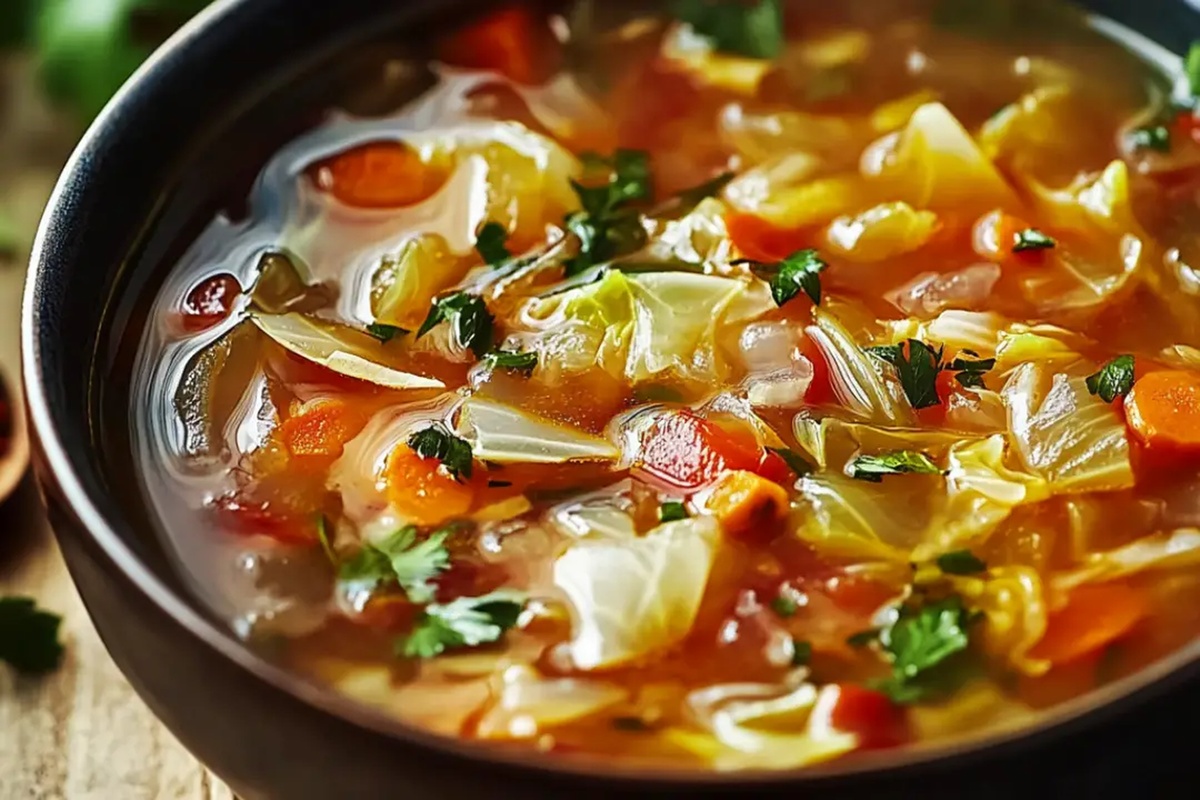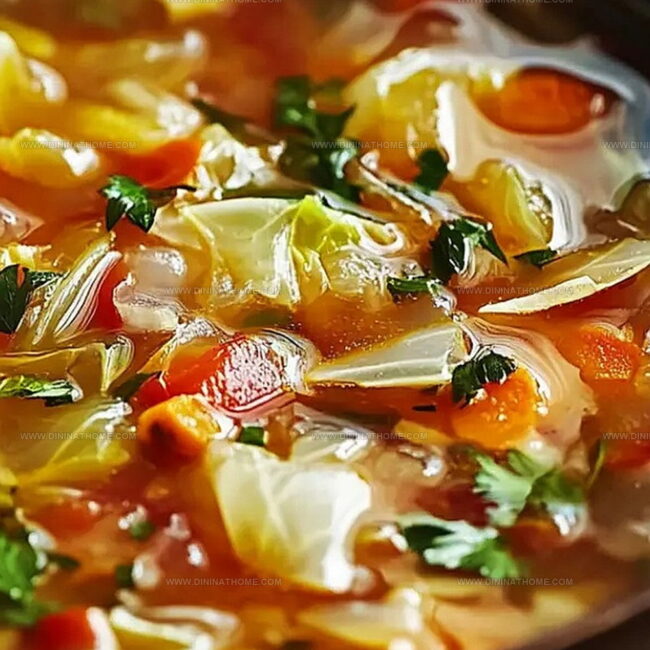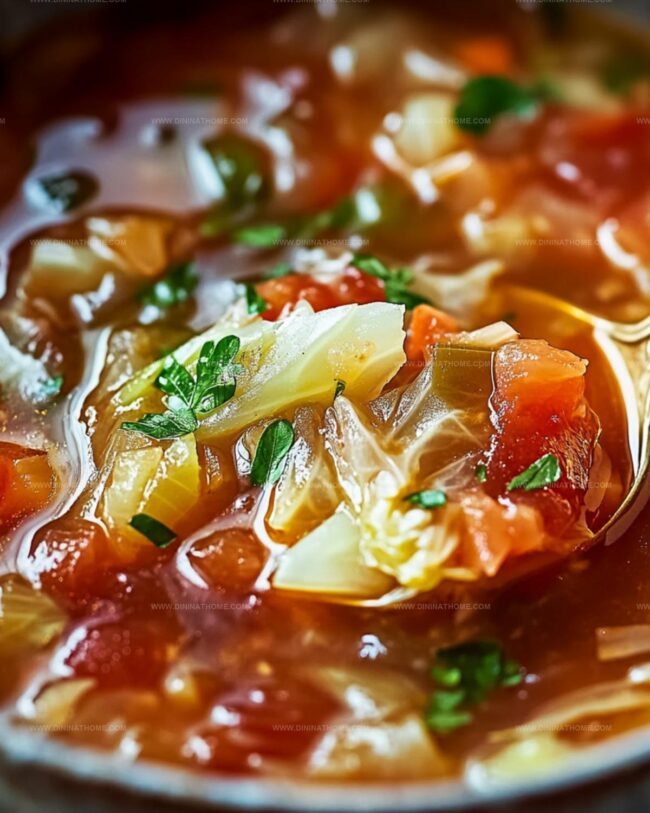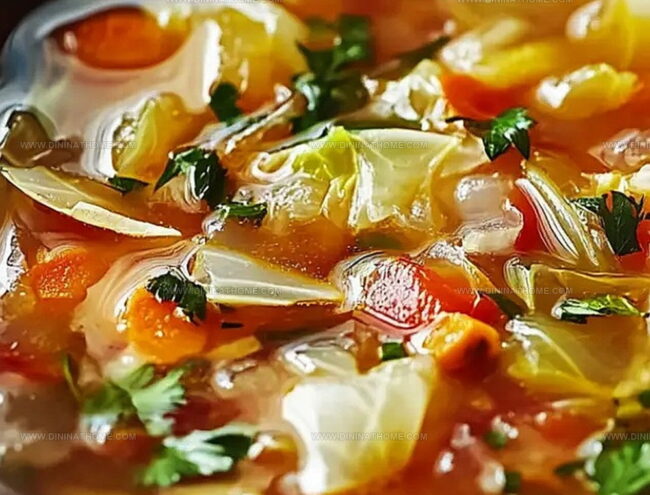Hearty Cabbage Soup Recipe: A Bowl of Cozy Comfort
Hearty cabbage soup has been my comfort food during chilly winters in Poland.
Memories of my grandmother’s kitchen inspire this wholesome dish that warms from the inside out.
Packed with nutrients and incredible flavor, this recipe brings simplicity and nourishment to your table.
Simple ingredients combine to create a meal that feels like a culinary hug.
Chopped vegetables and tender cabbage mingle in a rich broth that promises satisfaction.
Home cooks can easily master this delightful recipe with minimal effort.
Let’s transform ordinary ingredients into an extraordinary meal that will become your new favorite winter staple.
Cabbage Soup That’s Comforting, Nourishing, And Surprisingly Flavorful
Everything Required for the Best Cabbage Soup
Base Vegetables:Aromatics and Herbs:Liquid and Seasoning Components:Cabbage Soup Instructions for the Best Comfort Bowl
Step 1: Fire Up the Cooking Vessel
Grab a large pot or Dutch oven and heat olive oil over medium-high heat until it’s shimmering and ready to cook.
Step 2: Sauté Aromatic Vegetables
Toss in these colorful veggies:Sauté the vegetables for 4-5 minutes until they become soft and release their delightful fragrance.
Step 3: Awaken the Flavor Builders
Add these flavor-packed ingredients:Stir constantly for 1 minute to help the spices dance and release their intense flavors.
Step 4: Create the Soup Base
Drop in these hearty ingredients:Mix everything thoroughly, then bring the mixture to a bubbling boil.
Step 5: Simmer to Perfection
Reduce heat to low and let the soup gently simmer for 10-15 minutes until the cabbage becomes wonderfully tender.
Step 6: Final Flavor Boost
Stir in fresh lemon juice and chopped parsley just before serving to brighten the soup’s profile.
Step 7: Season and Serve
Taste and adjust with additional salt and cracked black pepper to make the flavors pop.
Ladle into bowls and enjoy your comforting cabbage soup!
Comforting Cabbage Soup Secrets
Save Best Cabbage Soup for Later
Simple Pairings for Cabbage Soup
Cabbage Soup Enhancements to Try
FAQs
Absolutely! This soup is packed with nutrients, low in calories, and rich in fiber. It’s a great option for those looking to eat nutritiously while enjoying a delicious, warming meal.
Yes, the recipe is already vegetarian as it uses vegetable broth. It’s naturally plant-based and perfect for vegetarian diets.
Try adding cooked beans like white beans or chickpeas, or include cubed tofu. These additions will boost the protein content without changing the soup’s core flavor profile.
Green cabbage is ideal for this recipe because it holds its texture well and provides a mild, slightly sweet flavor. However, you can also use Napa or savoy cabbage if preferred.
Print
Best Cabbage Soup Recipe
- Total Time: 30 minutes
- Yield: 6 1x
Description
Hearty Polish cabbage soup dances with robust flavors, warming hearts from Warsaw’s bustling kitchens. Comforting ingredients meld together, creating a nourishing bowl that connects you to generations of culinary tradition.
Ingredients
Vegetables:
- 1/2 head of cabbage, chopped
- 1 large carrot, diced
- 1 onion, diced
- 2 celery stalks, diced
- 2 garlic cloves, minced
Canned/Liquid Ingredients:
- 1 (14-ounce / 400 grams) can diced tomatoes
- 4–6 cups vegetable broth
- 1/2 tablespoon lemon juice
Herbs and Seasonings:
- 1/2 teaspoon dried oregano
- 1/2 teaspoon dried basil
- 1/2 teaspoon salt
- 1/4 cup fresh parsley, roughly chopped
- Cracked black pepper, to taste
- 2 tablespoons olive oil
Instructions
- Warm olive oil in a spacious cooking vessel over moderate heat, creating a fragrant base for the soup.
- Introduce diced onion, carrot, and celery into the pot, gently sautéing until the vegetables soften and release their aromatic essence, approximately 4-5 minutes.
- Incorporate minced garlic, dried oregano, dried basil, and salt, stirring vigorously to awaken the herb’s intense flavors and create a robust foundation.
- Allow the herb-infused mixture to bloom for a brief moment, ensuring the garlic becomes translucent and the spices distribute evenly.
- Cascade chopped cabbage, diced tomatoes, and vegetable broth into the pot, creating a vibrant and hearty liquid landscape.
- Thoroughly mix the ingredients, bringing the liquid to a vigorous boil before reducing to a gentle simmer that allows the cabbage to tenderize and flavors to harmonize.
- Let the soup simmer for 10-15 minutes, monitoring the cabbage’s texture and ensuring it becomes perfectly soft yet retains a subtle crispness.
- In the final moments of cooking, brighten the soup with a splash of lemon juice and a generous sprinkle of fresh parsley, lifting the entire dish with a burst of freshness.
- Taste and adjust seasoning, adding additional salt and cracked black pepper to personalize the soup’s flavor profile.
Notes
- Boost veggie intake by adding extra vegetables like zucchini, bell peppers, or spinach for more nutrients and flavor variety.
- Transform soup into a protein-packed meal by adding cooked chickpeas, white beans, or shredded chicken for extra substance.
- Enhance soup’s depth by roasting vegetables before adding them to the pot, which intensifies their natural sweetness and creates a richer taste profile.
- Store leftovers in airtight containers for up to 4 days, noting that flavors will develop and improve over time, making the soup even more delicious when reheated.
- Prep Time: 5 minutes
- Cook Time: 25 minutes
- Category: Lunch, Dinner
- Method: Sautéing
- Cuisine: American
Nutrition
- Serving Size: 6
- Calories: 90
- Sugar: 4g
- Sodium: 500mg
- Fat: 5g
- Saturated Fat: 1g
- Unsaturated Fat: 3g
- Trans Fat: 0g
- Carbohydrates: 10g
- Fiber: 2g
- Protein: 3g
- Cholesterol: 0mg





James Walker
Lead Recipe Developer & Culinary Educator
Expertise
Southern Cuisine & Farm-to-Table Cooking, Recipe Development & Testing, Culinary Education & Instruction
Education
School: Auguste Escoffier School of Culinary Arts
Program: Diploma in Culinary Arts and Operations
Focus: Comprehensive training in classical and modern culinary techniques, kitchen operations, and farm-to-table practices.
James didn’t learn cooking from a TV show, he learned it from busy kitchens, family gatherings, and long afternoons spent testing recipes the hard way.
After training at the Auguste Escoffier School of Culinary Arts, he brought his love for real, down-to-earth food to every dish he makes.
At Dining At Home, James loves building recipes that feel familiar but still have something special, like adding a twist to a classic or making a slow Sunday dinner feel brand new.
When he’s not in the kitchen, you’ll probably find him swapping garden tips at the farmers’ market or teaching his daughter how to flip pancakes without a mess (almost).